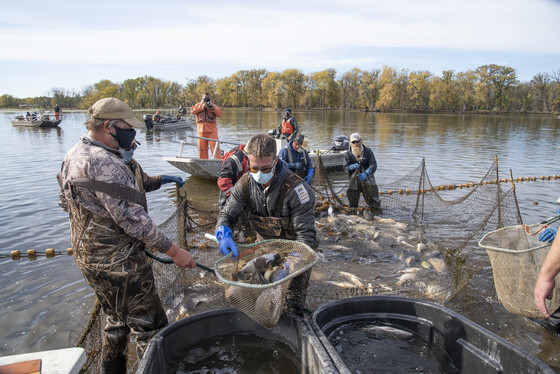FOR IMMEDIATE RELEASE: Nov. 15, 2021
Contact: DNR Office of Communications
DNRPress@wisconsin.gov

The Wisconsin DNR will continue working with neighboring state and federal agencies to reduce the number of invasive carp in the Mississippi River. / Photo Credit: Minnesota DNR
LA CROSSE, Wis. – The Wisconsin Department of Natural Resources (DNR) in partnership with neighboring state and federal agencies will take further action to reduce the number of invasive carp in the Mississippi River.
Additional actions include increasing commercial netting operations, tracking tagged carp and ongoing use of the innovative Modified Unified Method (MUM), a tactic that involves driving fish towards a series of smaller and smaller areas until they are netted out of the water.
Continued efforts follow a successful second invasive carp removal effort on Oct. 25-29 in Pool 8 of the Mississippi River near La Crosse in which the DNR, Minnesota Department of Natural Resources, U.S. Geological Survey, U.S. Fish and Wildlife Service, Wild Rivers Conservancy and National Park Service sampled more than 100,000 pounds of fish.
Although seven silver carp were observed jumping out of the sampling area, no invasive carp were captured during the October removal using MUM. Thirty-four silver carp were captured during the first MUM operation in the same locations in April.
“This is potentially very good news about the current status of invasive carp in Pool 8,” said Jordan Weeks, DNR Mississippi River Fisheries Biologist. “Invasive carp captures decreased sharply. We’re hopeful this indicates a decrease in the actual invasive carp population.”
In addition, the October invasive carp removal produced hundreds of native fish in each of five locations along the river. These captures included a healthy number and diversity of native fish, including numerous paddlefish and sturgeon.
While native fish tend to hide and avoid being driven into the nets used during the MUM tactic, some do end up being netted. A subset of those fish are measured and weighed, then released back into the river. Any invasive carp are removed and further analyzed. Invasive carp compete with native species for food and habitat, so a healthy and diverse fishery is a positive sign.
